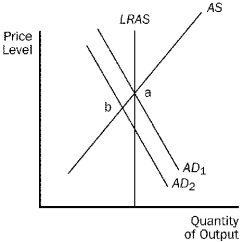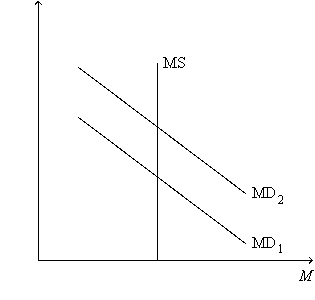A) multiplier effect on aggregate supply.
B) multiplier effect on aggregate demand.
C) liquidity-enhancing effect on aggregate supply.
D) liquidity-enhancing effect on aggregate demand.
F) All of the above
Correct Answer

verified
Correct Answer
verified
Multiple Choice
For the following questions,use the diagram below:
Figure 34-6.  -Refer to Figure 34-6.Which of the following is correct?
-Refer to Figure 34-6.Which of the following is correct?
A) A wave of optimism could move the economy from point a to point
B) If aggregate demand moves from AD1 to AD2,the economy will stay at point b in both the short run and long run.
C) It is possible that either fiscal or monetary policy might have caused the shift from AD1 to AD2.
D) All of the above are correct.
F) All of the above
Correct Answer

verified
Correct Answer
verified
Multiple Choice
Which of the following policies would be advocated by proponents of stabilization policy when the economy is experiencing severe unemployment?
A) a decrease in the money supply
B) a reduction in tax rates
C) a decrease in government purchases
D) None of the above is correct.
F) B) and D)
Correct Answer

verified
Correct Answer
verified
Multiple Choice
If households view a tax cut as temporary,then the tax cut
A) has no affect on aggregate demand.
B) has more of an affect on aggregate demand than if households view it as permanent.
C) has the same affect as when households view the cut as permanent.
D) has less of an affect on aggregate demand than if households view it as permanent.
F) B) and C)
Correct Answer

verified
Correct Answer
verified
Multiple Choice
Which of the following events would shift money demand to the left?
A) an increase in the interest rate or an increase in the price level
B) an increase in the interest rate,but not an increase in the price level
C) an increase in the price level,but not an increase in the interest rate
D) neither an increase in the interest rate nor an increase in the price level
F) A) and C)
Correct Answer

verified
Correct Answer
verified
Multiple Choice
A decrease in the interest rate could have been caused by the money-demand curve shifting
A) leftward because the price level fell.
B) leftward because the price level rose
C) rightward because the price level fell.
D) rightward because the price level rose.
F) B) and C)
Correct Answer

verified
Correct Answer
verified
Multiple Choice
During periods of expansion,automatic stabilizers cause government expenditures
A) and taxes to fall.
B) and taxes to rise.
C) to rise and taxes to fall.
D) to fall and taxes to rise.
F) A) and B)
Correct Answer

verified
Correct Answer
verified
Multiple Choice
The government buys new weapons systems.The manufacturers of weapons pay their employees.The employees spend this money on goods and services.The firms from which the employees buy the goods and services pay their employees.This sequence of events illustrates
A) the accelerator effect.
B) the multiplier effect.
C) the chain effect.
D) the bandwagon effect.
F) A) and C)
Correct Answer

verified
Correct Answer
verified
Multiple Choice
The positive feedback from aggregate demand to investment is called
A) the investment multiplier.
B) the stock-market effect.
C) the investment accelerator.
D) the crowding-in multiplier.
F) A) and D)
Correct Answer

verified
Correct Answer
verified
Multiple Choice
Which of the following is not a reason the aggregate-demand curve slopes downward? As the price level increases,
A) firms may believe the relative price of their output has risen.
B) real wealth declines.
C) the interest rate increases.
D) the exchange rate increases.
F) None of the above
Correct Answer

verified
Correct Answer
verified
Multiple Choice
Which of the following properly describes the interest-rate effect that helps explain the slope of the aggregate-demand curve?
A) As the money supply increases,the interest rate falls,so spending rises.
B) As the money supply increases,the interest rate rises,so spending falls.
C) As the price level increases,the interest rate falls,so spending rises.
D) As the price level increases,the interest rate rises,so spending falls.
F) C) and D)
Correct Answer

verified
Correct Answer
verified
Multiple Choice
According to the theory of liquidity preference,an increase in the price level causes the
A) interest rate and investment to rise.
B) interest rate and investment to fall.
C) interest rate to rise and investment to fall.
D) interest rate to fall and investment to rise.
F) All of the above
Correct Answer

verified
Correct Answer
verified
Multiple Choice
Figure 34-4.On the figure,MS represents money supply and MD represents money
demand.  -Refer to Figure 34-4.What is measured along the vertical axis of the graph?
-Refer to Figure 34-4.What is measured along the vertical axis of the graph?
A) the quantity of output
B) the amount of crowding out
C) the interest rate
D) the price level
F) A) and C)
Correct Answer

verified
Correct Answer
verified
Multiple Choice
If expected inflation is constant,then when the nominal interest rate increases,the real interest rate
A) increases by more than the change in the nominal interest rate.
B) increases by the change in the nominal interest rate.
C) decreases by the change in the nominal interest rate.
D) decreases by more than the change in the nominal interest rate.
F) A) and D)
Correct Answer

verified
Correct Answer
verified
Multiple Choice
If Congress cuts spending to balance the federal budget,the Fed can act to prevent unemployment and recession by
A) buying bonds to increase the money supply
B) buying bonds to decrease the money supply.
C) selling bonds to increase the money supply.
D) selling bonds to decrease the money supply.
F) All of the above
Correct Answer

verified
Correct Answer
verified
Multiple Choice
Assume the MPC is 0.625.Assuming only the multiplier effect matters,a decrease in government purchases of $10 billion will shift the aggregate demand curve to the
A) left by about $13.3 billion.
B) left by about $26.7 billion.
C) right by about $36.7 billion.
D) None of the above is correct.
F) A) and C)
Correct Answer

verified
Correct Answer
verified
Multiple Choice
Which among the following assets is the most liquid?
A) corporate bonds
B) fine art
C) deposits that can be withdrawn using ATMs
D) mutual funds
F) C) and D)
Correct Answer

verified
Correct Answer
verified
Multiple Choice
Assume the money market is initially in equilibrium.If the price level increases,then according to liquidity preference theory there is an excess
A) supply of money until the interest rate increases.
B) supply of money until the interest rate decreases.
C) demand for money until the interest rate increases.
D) demand for money until the interest rate decreases.
F) B) and D)
Correct Answer

verified
Correct Answer
verified
True/False
According to the theory of liquidity preference,the interest rate adjusts to balance the supply of,and demand for,loanable funds.
B) False
Correct Answer

verified
Correct Answer
verified
Multiple Choice
If expected inflation is constant and the nominal interest rate increases by 2 percentage points,then the real interest rate
A) increases by 2 percentage points.
B) increases,but by less than 2 percentage points.
C) decreases,but by less than 2 percentage points.
D) decreases by 2 percentage points.
F) C) and D)
Correct Answer

verified
Correct Answer
verified
Showing 81 - 100 of 334
Related Exams